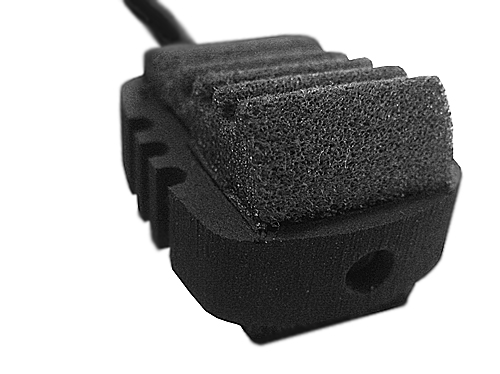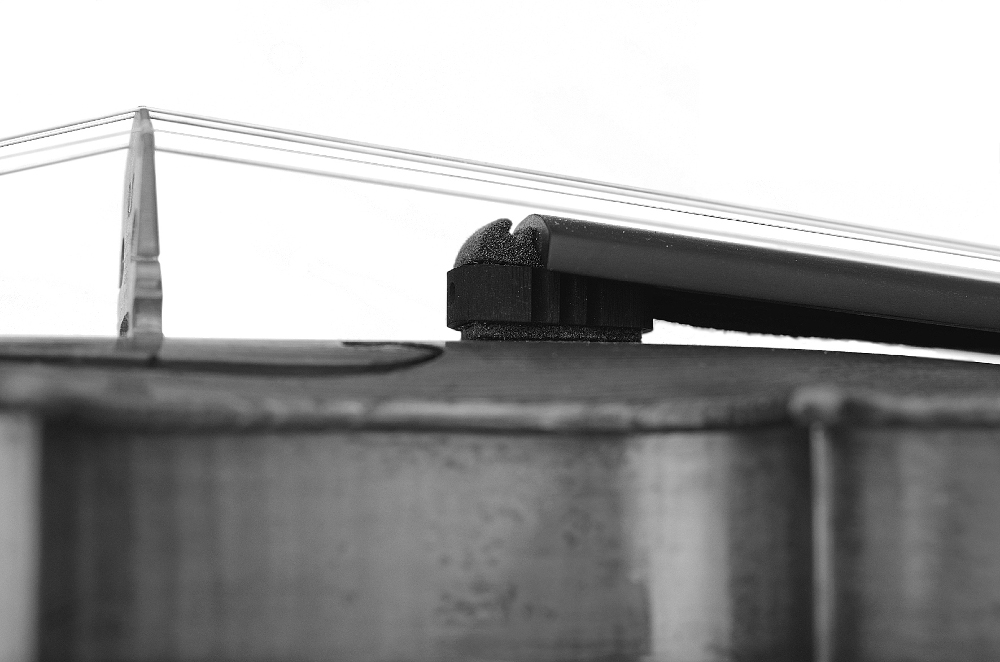Research & Development: The REMIC V5200 Microphone for Classical Instruments
What does the “RE” in Danish maker REMIC Microphones‘ name stand for? Purely speculating, REady to REthink and REvolutionize mic design all seem plausible.
The most unusual REMIC has emerged as a different kind of high definition condenser microphone for classical instruments. It required out-of-the-box thinking and a 30-year process to make a new kind of mic possible – sparked by fundamental discoveries about microphone design dating generations back.
Along the way, an unexpected journey arose for REMIC inventor Thorkild Larsen. Before the REinvention could take place, his early prototypes spawned more confounding mysteries, ones which would require historical investigation spanning centuries to untangle.
The classical instrument itself — violin, viola, cello, double bass — would have to be REdiscovered to REalize his vision. A new round of research and scientific understanding awaited Larsen at every turn. But he wasn’t just crunching numbers and developing a new condenser element, as bigger questions were also addressed: What constitutes an actual performance? What does that really sound like?
With this inside view on Larsen’s “Research & Development” of the REMIC V5200 microphones for violin and viola, look for more than just the technical. If you’ve got your own audio idea in mind, his wild ride is a guide for turning life experience into fresh solutions.
Inventor Thorkild Larsen — The Back Story: I have a background as a musician myself and a degree in electronical engineering. I learned what it was like being on stage, what it was like to do sound in a live environment, and in studios as a sound engineer.
For many years, I had my own company servicing high-end microphones for the Danish National Broadcast Organization. After all of that servicing and testing different types of microphones, dynamic microphones – piezoelectric microphones –ribbon mics and condenser mics, I found most of the designs as “copycats” carrying same errors, when it comes to accuracy in reference to an acoustic sound source.
It occurred to me that most of the mic constructions and designs were copies of each other. They all carried identical base designs – and therefore also identical “errors” like a huge amount of self-resonance. Small changes in designs added different tonal characteristics to each brand and model of microphone – which can be very charming to the microphone enthusiasts, and very useful in “the older days” at a time when the equalizer tool was not as developed as today and therefore sound engineers utilized the tonal difference of microphones to EQ the recordings.
I decided to start out a “microphone project” and the goal was to design a “self-resonance free” mic element able to capture the energy structure of moving air molecules and convert that energy structure to an exact flow of electron structure, with as little distortion as possible.
Based on my experience with different types of microphones, I chose the design of a small condenser element, as this design seemed the easiest to work with. It’s relatively simple, stable and has a wide response to both frequency and dynamics.
Identifying the Challenge of Capturing Classical Instruments with Traditional Microphones: Often the sound of classical instruments are captured from a distance, which can be fine. However, the fact is that a lot of information is lost when doing it this way. I’m not saying that it is the wrong way of capturing sound when choosing these “old methods” – I only want you to consider the following:
When recording the sound of classical instruments, the tradition has always been to avoid “odd sounds” such as a finger touching or sliding against a string, or the “touch down” of the bow onto the strings” and only focus on the tones of the instruments and room acoustics.
However, to many musicians and artists, music is much more than only the tones of an instrument, fundamentals and overtones. And as an audience, we want to hear the real instrument played by real human beings, which is what really brings life to the music. We want to be able to almost “smell the wood of the violin” or to feel the intimate atmosphere of the symphony orchestra in the concert hall or brought to you by a set of loudspeakers in your living room. Not some static and absolute perfect performance, but a “living” performance.
What we have experienced during the past 30 years is that when recording classical instruments from a distance, we lose a lot of very useful information – actually we lose some of the most basic information on overtones, the accuracy of attacks and dynamics.
Think of it this way: We have to capture the sound of every single detailed movement on the instrument, and bringing these fine details to the listener through a set of high definition loudspeakers and from there each instrument will “bloom” and blend with the room acoustics, whether you are in a concert hall or listening on a pair of speakers in your living room or recording studio.
If the recording takes place in a concert hall, where the room acoustics also matter – we can benefit from combining close miking with ambient miking – and this way preserve proximity, the finest details, accuracy of attacks and overtones as well as dynamics and the fine room acoustics.
I am well aware that some professionals might disagree to some point, but I really think that people should give themselves the opportunity and time to discover and experience these recording techniques.
A New “Ideal Outcome:” I wanted to accurately reproduce the true sound of the instrument. This is mostly not the case with the solutions that exist in the market.
I wanted to create a microphone where the individual artist could actually hear that it is his/her particular instrument being played, with all the finest nuances of sound that the instrument was chosen for and the individual style of the artist. They spend a lifetime creating their own sound and this is what I wanted to capture.
Designing the REMIC V5200 — The Road Map: We often compare frequency responses and polar patterns of microphones, but these data have been obtained under different conditions, not mounted on an instrument.
The fact is that when mounting a microphone on an instrument – let us take an example of the well known clip-on gooseneck microphone — these mics often come with a cardioid profile (as obtained in an anechoic chamber). But when mounted on the instrument, pointing towards a reflective plane (the top of the violin) the characteristics of the polar pattern and parts of the frequency response change dramatically.
This fine set of data varies a lot, depending on angle and distance to the surface of the instrument. Therefore, the set of data obtained in the anechoic chamber, provided by the manufacturer – will play a very little role and often none at all, simply because the prerequisites have dramatically changed, when playing in an environment with different sonic conditions.
These data sets can be used by the manufacturer to assure that the production of a series of microphone elements are kept within the pre-specified tolerances, and not as a user guide from “real world” usages.
The sonic environment plays a great role to the final outcome. And we also found that the characteristics of a violin changed when played in a loud sonic environment, such as on a large stage with many stage monitors, drumkits and other electronically amplified instruments (bass and guitars) versus in a recording studio. I remember, when I use to tune my acoustic guitar on a live gig, while all others were playing their instruments, I use to put one ear to the back of the instrument and that way I could hear MY instrument.
On this background I decided to design an instrument microphone that was able to capture the sound of the violin in a harsher sonic environment – still providing a lot of fine details of the instrument. This was when I realized that two microphone models were needed: The V5200 for studio and small live performances and the V5200LB for extreme live performances (such as rock and pop).
Two Kinds of Capture: Any model of the REMICs for bowed instruments has been designed to capture the near field sound of the instrument and to suppress ambient noises in different ways.
The REMIC V5200 studio/live model has an omnidirectional polar pattern and a low level of ambient suppression. However, the REMIC studio model can also be used in live context, where the sound of the instruments has to be “lifted” just a bit. e.g amplification of a symphony orchestra, classical string quartets, ensembles or jazz.
The REMIC V5200LB “LB” model is designed for “extreme loud” live performances, such as folk-rock, pop, rock and metal.
The LB model is designed to suppress a large amount of ambient noises and the polar pattern of this model mounted on the instrument is unidirectional and more specific, an angled figure eight within the reach of the soundboard area. Outside this area, the polar pattern becomes omni directional. This model is aimed for live productions with high level of sound pressure on stage. Astonishing high gain before feedback. Extreme suppression of neighbour instruments and ambient noise.
Please note that the sound response of the “LB” models are more “dry” and “woodish” in comparison to the “Studio/Live” models, due to their high ambient suppression factor, but can easily be EQ’d for best results.
This video demonstrates the “LB’s” extreme loud capabilities:
The REMIC Live “Extreme” Model: When using the LB model you will experience, to some degree, a “woodish” sound response or what some would describe as a “hollow” sound, especially compared to the sound response the REMIC Studio/Live model. This has its natural causes.
Classical bowed instruments — violin, viola, cello and upright bass — have been designed with a soundboard (belly) and a sound box (body) that have a certain pattern of resonance in order to accomplish the acoustic amplification of the vibrating strings.
Feels Like the First Time — Impressing the Audio Pros: As a starting point, audio professionals are really curious to try out new equipment. The look of the REMICs and the way they are easily placed on the instruments are elements that are so surprising to them that they are immediately curious about the microphones. The hardest thing to explain is that you need a specific microphone for a specific instrument and then also for the sonic environment (studio vs. live).
The next element that I have to explain is that they have to use their ears to listen to the instrument, and not to a reference microphone. The source is the instrument, not other microphones.
Then they have to reset the EQ and start over since REMICs capture the nuances of the sound to a much greater extent than most microphones. Sometimes the gain even has to be lowered to express less nuances – this is particularly the case of our microphones for studio/live (studio and small live performances). Violinists have expressed that it is a big responsibility to play with a REMIC since virtually all details are captured.
Making the REMIC a REality — A Serious Learning Curve: At the beginning, I developed what I thought was a “universal” microphone model. During the intense work with the second version of the prototype microphone for violin, we compared the recordings with the acoustic sound of the instrument and experienced that some parts of the sound were “missing” or suppressed. The more I listened to the instruments vs. the sound that was captured, I discovered that I had to get closer to the instruments, learn in depth how the bowed string instruments (violin, viola, cello and double bass) amplify their own sound.
I had to seek out the expertise of the instrument makers – a knowledge that had been passed down through generations of luthiers since the great makers like Stradivari and Guarneri. I had to rediscover what kind of instrument the violin is. Where does the idea come from? And what was the purpose of designing an instrument like this?
Exploring the history of violin making such as, Stradivari and Guarneri, suggests that they wanted to create an instrument, capable of mimicking the human voice – an understanding which later has been proven, to some point by professor Joseph Nagyvary and published in “Savart Journal”, a scientific journal of musical instrument acoustics.
This information led me to not only study the construction and tonal behavior of the violin, but also to dig deeper into the study of both the human voicing organ as well as the human ear, in order to get a deeper knowledge regarding this instrument and what these old instrument makers were thinking.
Instrument Acoustics and Energy Displacement Emerge: All of this turned out to be quite a journey, experiencing that neither theories of general acoustics, room acoustics nor vibration acoustics or any combinations thereof or musical instrument acoustics, could cover and explain the physics of this instrument.
This led to another approach – linear and nonlinear energy displacement theories. Through the work in this field even the most complex structure of acoustics could be determined.
It turned out that all acoustic information, such as the fine balance between the fundamental tone register and the primary — and secondary overtone register, attacks and full range dynamics — was represented all over the soundboard or belly of the instrument, with a few points of “hot spots” along the meridian-axis of the instrument.
It also turned out that the point of capturing the sound should be done at the right angle and distance (height) to the soundboard or belly of the instrument in order to preserve the correct balance in frequency phase between fundamentals and the secondary overtone register. By working the math around linear- and non-linear- energy displacement – it became possible to deviate from the “old formulas” normally used.
This Does NOT Look Like a Microphone! A Totally Different Form Factor: A lot of issues were addressed in order to create the right design.
First and foremost, we needed the sound response of the acoustic sound of the instrument to be correct, but also to keep the aesthetics of these fine instruments intact by avoiding any clamps and clips and goose necks sticking out of the instrument, disturbing the sound and the view from the musician’s perspective. You basically need to know how the instrument works in the first place, but also how the musician is playing the instrument in order not to complicate things for the artist.
Often we have seen gooseneck mics being swept off the violin, when the bow hits the mic, or artists gets hit in the eye or forehead by the gooseneck mic. Apart from that, it also about the overall aesthetics of an orchestra. When 40 goosenecks stick out from these fine old instruments it is not exactly the most aesthetic experience – this being from the audience point of view.
REMICS are hidden on the instruments and to the silicone microphone cable, we also added a cotton woven “outer jacket” in order to prevent any “rattle” noises if the cable should touch the violin body. The composite material for the foam material used for the REMIC housing and placement has been developed over several years to provide perfect fit as well as a correct tension in order to hold the microphone in place.
So Here’s Where It Goes…The microphone for violin, viola and cello are placed under the fingerboard, on the double bass the REMIC is placed under the tailpiece. The ideal placement of the microphones was chosen according to how the sound moves on the instruments and where the “sweet spots” are on the instruments – this is the result of many years of research of instruments together with the instrument makers.
Furthermore, the unique placement gives the musicians a great deal of freedom to move during a performance or studio recording since they do not depend on a microphone on a stand.
The placement and the particular foam material that they are made of make it incredibly easy and quick to mount the microphones – a benefit that both musicians and sound engineers really appreciate as they save a lot of time when placing the microphones.
See exactly how the LV5200 works in this review:
Who’s Gone First, and Who’s Still Thinking About It: Early adopters of REMICs have been musicians and artists who have tried everything else and are still not satisfied with other solutions. Another group of early adopters are part of the younger generations who are not afraid of trying out new technologies.
Until now, the most conservative users who needs convincing have been the classical segment, even though the REMICs were originally designed for this very segment. The reason for this is that “traditions” often stand in the way. If you lock yourself to traditions – well then you are going nowhere.
What’s YOUR Invention? How to Step Out of the (Audio) Box: I think the biggest lesson is that introducing an innovative type of microphone is resistance from traditions and habits in the industry.
Innovation makes it easier to get attention and people are incredibly curious to try out our microphones, but there are some serious mental barriers that we have to meet every day to explain why different sonic environments need different microphones and why they are so instrument-specific that they cannot be used as a standard solution for other instruments.
If I were to give a piece of advice it is still to follow radically new ideas but be ready to meet resistance of habits.
To create totally new gear for the audio world, I believe you have to be equipped with a tremendous curiosity and urge to never settle for something that is just “OK” – as long as there are flaws, there is room for improvement.
I can only speak for myself, and in the case of REMIC, I actually came up with this approach by observing musicians, sound engineers and putting myself on stage as a musician in my younger years. Later I worked as a sound engineer, so my approach has been listening and collaborating with an entire community of musicians, sound engineers and instrument makers. So one idea is never enough. Curiosity is what drives innovation and then after a long process, you may end up with something innovative, but it never comes to you overnight.
Another important aspect is to have empathy as a natural part of your character. Empathy allows you to mentally put yourself in other people’s shoes, to really listen to genuinely understand their challenges – this is the first step to be innovative. If you do not genuinely understand the challenges of other people, then you are not really solving any problem.
This process with REMIC took me over 30 years with all the steps and the peculiar constellation of elements such as personal background, a curiosity that never sleeps, optimism, a vivid imagination and a willpower that works even stronger when I meet resistance.
— Thorkild Larsen, REMIC Microphones
Please note: When you buy products through links on this page, we may earn an affiliate commission.










